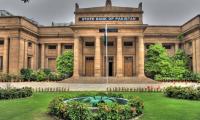NEW YORK: The US economy added 275,000 jobs last month, beating forecasts, but big downgrades to previous figures fuelled expectations of as many as four interest rate cuts this year.
The non-farm payroll figures for February surpassed economists’ predictions of 200,000 new jobs and indicated that the US’s services sector remains strong. However February’s 275,000 jobs number was eclipsed by the revised totals for January and December, when 167,000 fewer posts were created than previously thought.
Bond yields dipped and stocks opened higher in response to the scale of Friday’s downgrades, as traders bet that a weaker labour market would allow the US Federal Reserve to cut interest rates sooner.
“The downward revisions to previous months’ gains leave recent growth looking less strong than previously thought,” said Capital Economics, a consultancy, in a note. The futures market fully priced in a quarter-point interest rate cut for June, shifting forward expectations.
Traders briefly priced in four interest rate reductions this year in the immediate aftermath of the release. The Fed itself forecasts three cuts this year. The two-year Treasury yield, which moves with interest rate expectations, dipped, leaving it down 0.05 percentage points on the day at 4.46 per cent.
The S&P 500 was up about 0.5 per cent in mid-morning trading on Friday and on track to close at a record high. In Friday’s release, the Bureau of Labor Statistics downgraded the new jobs total for January from a blockbuster initial reading of 353,000 to 229,000. December’s figure was cut from 333,000 to 290,000.
The BLS said February’s unemployment rate rose to 3.9 per cent from 3.7 per cent the month before. Wage growth also slowed, with average hourly earnings rising just 0.1 per cent in February.
“The robust February payroll figure is more than offset by downward revisions to December and January, the rise in the unemployment rate and the low wage figure,” said Stephen Stanley, US economist at Santander Bank.
“Still, the overall picture in my view is that the labour market is still healthy.” The February data indicated that jobs growth remained concentrated in the services sector, with significant increases in payrolls in healthcare, hospitality and the public sector.
“The strength of the economy continues to be in the services sector and we know [services inflation] is something that the Fed is watching,” said Diane Swonk, chief economist at KPMG US. Consumer price index inflation figures for February are due out on Tuesday.
Fed chair Jay Powell said on Thursday that the US central bank was “not far” from having the confidence to start lowering borrowing costs, as it awaited more concrete evidence that inflation is on track to hit the bank’s 2 per cent target.
But other rate-setters think there are signs that the US economy is too strong to warrant lower borrowing costs. Wei Li, global chief investment strategist for BlackRock, said the US labour market remained tight, arguing that the Fed would cut rates, “but not as soon or as early as the market has been expecting”. She added: “A June start for cuts is our baseline expectation, with three cuts this year.”
Acyclical sectors such as government and healthcare, which are still rebuilding headcount that was reduced during the Covid-19 pandemic, led employment gains last month. Nonetheless the breadth of job gains continued to broaden.
Healthcare payrolls increased by 67,000, driven by hiring in ambulatory healthcare services as well as at hospitals, nursing and residential care facilities. Government employment rose by 52,000, with gains in both local and federal governments. Restaurants and bars added 42,000 jobs.
Social assistance payrolls increased by 24,000 jobs, while employment in the transportation and warehousing sector rose by 20,000, amid a rebound in hiring for couriers and messengers, after shedding 70,000 jobs over the last three months.
Construction payrolls increased by 23,000 jobs. There were also gains in retail employment. But temporary help services, seen as a harbinger for future hiring, declined by 15,400 jobs. Manufacturing shed 4,000 jobs.
The unemployment rate increased to 3.9 percent, the highest level since January 2022, after holding at 3.7 percent for three straight months. The smaller household survey from which the jobless rate is derived showed a decline in employment.
That together with 150,000 joining the labor force accounted for the rise the unemployment rate. Still, fewer people were experiencing long bouts of unemployment in February. Despite a rash of high-profile layoffs at the start of the year, employers are generally holding on to their workers after struggling to find labor during the pandemic. Though labor supply and demand are falling back into balance, amid a rise in immigration and older workers delaying retirement, some sectors of the economy remain desperate for skilled workers.
There were 1.45 open jobs for every unemployed person in January, still above the average of 1.2 during the year before the pandemic, government data showed this week. The Fed's Beige Book report also showed "difficulties persisted attracting workers for highly skilled positions" in February.
Average hourly earnings edged up 0.1 percent last month after gaining 0.5 percent in January. That lowered the year-on-year increase in wages to a still-high 4.3 percent in February from 4.4 percent in January.
The picture shows a logo of Federation of Pakistan Chambers of Commerce & Industry . — APP/FileKARACHI: Atif Ikram...
The image shows the logo of the Securities and Exchange Commission of Pakistan . — APP/FileISLAMABAD: The Securities...
This image released on January 26, 2023, shows the logo of Archroma. — Facebook/ArchromaKARACHI: Archroma Pakistan...
The logo of the Trade Development Authority of Pakistan . — TDAP website. Mirpur: Kausar Taqadus Gilani, Minister...
This representational image shows Gold bars. — AFP/FileKARACHI: Gold prices in the local market dropped by Rs600 per...
Security personnel walk past the US Federal Reserve building in Washington, DC on Oct 22, 2021. —...







